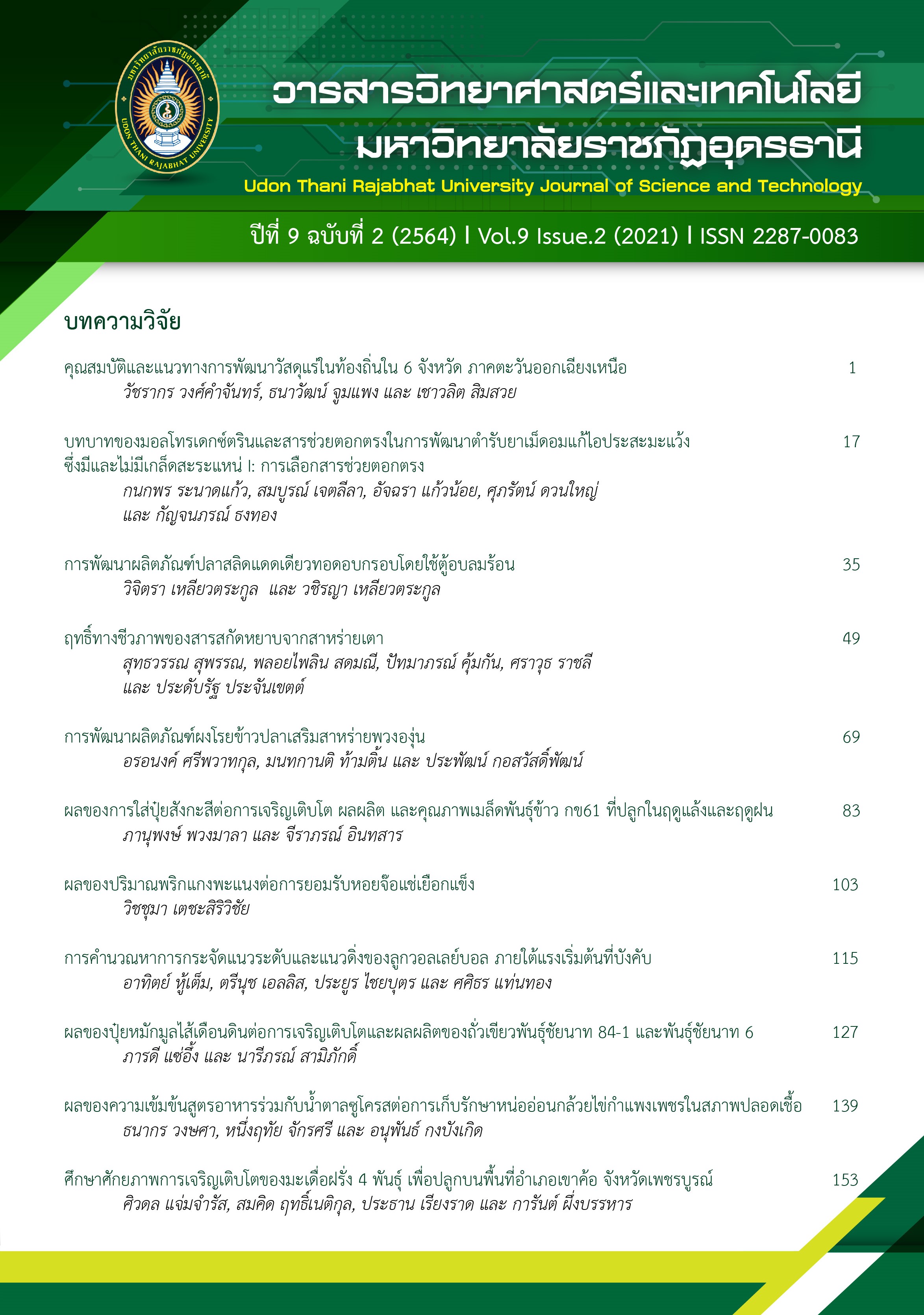THE BIOLOGICAL ACTIVITY OF SPIROGYRA SP. CRUDE EXTRACTS
Main Article Content
Abstract
The objective of this research was to study the antibacterial activity, polysaccharide content and antioxidant activity in Spirogyra sp. by using two types of solvents; ethanol and methanol. The results showed that the antibacterial activity test by disk diffusion assay found that the crude extract from Spirogyra sp. extracted with methanol solvent could inhibit the growth of Staphylococcus aureus the best with the size of the inhibitory area was 22.7 mm. According to the minimal inhibitory concentration (MIC), the research found that the crude extract from Spirogyra sp. with methanol solvent had the lowest MIC values against S. aureus and P. aeruginosa at the same value at 0.0625 mg/ml. The minimal bactericidal concentration (MBC) showed that the crude extract from Spirogyra sp. could not kill the bacteria. Polysaccharide content analysis revealed that Spirogyra sp. had polysaccharide content of 1.34 ± 0.413 percent of dry weight. The analysis of antioxidant activity revealed that the crude extract from Spirogyra sp. found that the inhibitory concentration at 50% (IC50) content of Spirogyra sp. extracted with ethanol solvent was 64.19 µg/ml and the IC50 content of the extract from Spirogyra sp. with methanol solvent was 64.15 µg/ml. In addition, the results of the examination of the compound content was all phenolics, the research found that Spirogyra sp. extracted by methanol solvent contained the highest total amount of phenolic compounds at 54.569 ±6.74 milligrams equivalent to gallic acid per 100 milliliters of weight, mg GAE/100 mL.
Article Details
References
ฐิติกานต์ ปัญโญใหญ่. (2551).กิจกรรมต้านออกซิเดชันของสาหร่ายเตา Spirogyra neglecta (Hassall) KÜtzing. (วิทยานิพนธ์ วิทยาศาสตร์มหาบัณฑิต สาขาชีววิทยา มหาวิทยาลัยเชียงใหม่. เชียงใหม่).
ปริญญา มูลสิน และ อมรรัตน์ วงษ์กลม. (2556). การศึกษาผลของการใช้สารสกัดจากสาหร่ายเพื่อเพิ่มมูลค่าผลิตภัณฑ์เครื่องสำอาง. รายงานการวิจัย สาขาวิชาชีววิทยา และสาขาวิชาเคมี คณะวิทยาศาสตร์. มหาวิทยาลัยราชภัฏอุบลราชธานี. อุบลราชธานี
พรรณรัตน์ อกนิษฐาภิชาติ และ เบญจภรณ์ เศรษฐบุปผา. (2563). ฤทธิ์ต้านอนุมูลอิสระ และฤทธิ์ปกป้องเซลลของสารสกัดจากผลพืชสกุลมะเขือ 4 ชนิด. วารสารเภสัชศาสตร์อีสาน, 16(1), 49-58.
ภารดี อินทจันทร์ และ วิภาเพ็ญ โชคดีสัมฤทธิ์. (2563). การศึกษาเปรียบเทียบประสิทธิผลของเจลสารสกัดใบบัวบก 5% กับเจลคลินดามัยซิน 1% ในการรักษาสิว. วารสารการแพทย์และวิทยาศาสตร์สุขภาพ, 27(1), 1-11.
ยุวดี พีรพรพิศาล. (2549). ศักยภาพของสาหร่ายน้ำจืดขนาดใหญ่ในการนำมาเป็นอาหารและยา. รายงานการวิจัย สำนักงานกองทุนสนับสนุนการวิจัย. กรุงเทพฯ
ยุวดี พีรพรพิศาล, ฐิติกานต์ ปัญโญใหญ่ และ ดวงพร อมรเลิศพิศาล. (2555). ฤทธิ์ต้านอนุมูลอิสระและต้านการอักเสบของสาหร่ายเตา. วารสารวิทยาศาสตร มข. 40(1), 238-235.
รัตนา อินทรานุปกรณ์. (2550). การตรวจสอบและการสกัดแยกสารสำคัญจากสมุนไพร. พิมพ์ครั้งที่ 2. กรุงเทพฯ: สำนักพิมพ์แห่งจุฬาลงกรณ์มหาวิทยาลัย.
รัตนาภรณ์ จันทร์ทิพย์, ฐิติพรรณ ฉิมสุข, อรุณี คงดี และ ดวงพร อมรเลิศพิศาล. (2555). พฤกษเคมีและผลของตัวทำละลายต่อปริมาณสารประกอบฟีนอลิกของสาหร่ายเตา (Spirogyra sp.). ใน: การประชุมเสนอผลงานวิจัยระดับบัณฑิตศึกษา มหาวิทยาลัย เชียงใหม่ ครั้งที่ 3, 23 พฤศจิกายน 2555. บัณฑิตวิทยาลัย มหาวิทยาลัยเชียงใหม่, เชียงใหม่. 15-22.
รวิสรา รื่นไวย. (2563). การวิเคราะห์ปริมาณฟีนอลิก และความสามารถต้านอนุมูลอิสระของสารสกัดจากดอกเก๊กฮวย. วารสารนเรศวรพะเยา, 13(1), 16-20.
รชตะ รุ่งตระกูลชัย, วุฒิ สุขเจริญ, อนุพงศ์ อวิรุทธา และ วัชรินทร์ โชติชัยชรินทร์. (2562). การศึกษาและวิเคราะห์แนวทางในการพัฒนาตลาดที่ใช้สารสกัดจากธรรมชาติ. วารสารสถาบันเทคโนโลยีไทย-ญี่ปุ่น : บริหารธุรกิจและภาษา, 7(1), 75-82.
อรรถพล อุทัยเรือง, รุจิลักขณ์ รัตตะรมณ์ และ คัทลียา เมฆจรัสกุล. (2563). การประยุกต์ทางเวชสำอางค์ของน้ำมันหอมระเหยว่านสาวหลงจากส่วนทั้งต้นและส่วนใต้ดิน. วารสารวิทยาศาสตร์และเทคโนโลยี, 9(5), 680-692.
Alshididi, S. S. & Jawad, A. (2015). Antagonistic activity of Spirogyra micropunctata against some multidrug resistant human pathogenic bacteria. Iraqi Journal of Science, 56 (3C), 2494-2498.
Assawarachan, R., Nookong, M., Chailungka, N., & Amornlerdpison, D. (2013). Effects of microwave power on the drying characteristics, color and phenolic content of Spirogyra sp. Journal of Food, Agriculture & Environment, 11(1), 15-18.
Demina, N. S. & Lysenko, S. V. (1996). Collagenolytic enzymes synthesized by microorganisms. Mikrobiologiia, 65(3), 293-304.
Patil K. J., Patil, A. V., Mahajan, S. R., & Mahajan, R. T. (2011). Bio-activity of algae belonging to Bhusawal region, Maharashtra. Current Biology, 2(1), 29-31.
Surayot U., Wang J., Lee J. H., Kanongnuch C., Peerapornpisal Y. & You S. G. (2015). Characterization and immunomodulatory activities of polysaccharides from Spirogyra neglecta (Hassall) Kützing. Bioscience, Biotechnology, and Biochemistry, 79(10), 1644–1653.
Sitthiwong, N. (2019). Pigment and nutritional value of Spirogyra spp. in Sakon Nakhon, Nakhon Phanom and Mukdahan provinces. Science and Technology RMUTT Journal, 9(1), 10-21.
Tanna, b. & Mishra, A. (2019). Nutraceutical potential of seaweed polysaccharides: structure, bioactivity, safety, and toxicity. Comprehensive Reviews in Food Science and Food Safety, 18(3), 817-831.
Thumvijit, T., Inboot, W., Peerapornpisal, Y., Amornlerdpison, D., & Wongpoomchai, R. (2013). The antimutagenic and antioxidant properties of Spirogyra neglecta (Hassall) Kützing. Journal of Medicinal Plants Research, 7(34), 2494-2500.
Yosboonruang, A., Duangjai, A., Amornlerdpison, D., & Viyoach, J. (2020). Screening for Biological Activities of Spirogyra neglecta Water Extract. Walailak Journal of Science and Technology, 17(4), 359-368.

